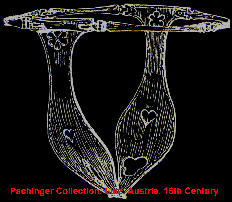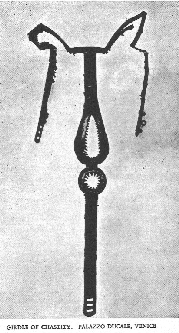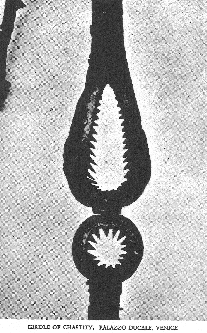

This page still under construction


This page still under construction
Few individuals in the Western world are not
familiar with some form of story about chastity belts and their use
during the Middle Ages, a mechanical contrivance inspired by mistrust
and jealousy between the sexes.
Possibly adopted by knights, returning from their Crusades during the
early 12th century, the chastity belt has taken up a whole new
chapter during the European Renaissance. In addition, the subject
matter has also inspired many poets and satirists of the time to
enliven their themes, by paying heed to human folly.
Yet, despite it's hay-day during the 16-18th century and writings
from various countries -specifically Germany, Italy and France-
hardly any research has been conducted, and at this time few
individuals are versed enough to separate truth from fiction.
Actual evidence lies somewhere in a different fold -unbeknownst to
even many museum curators in position to study such rarities up
close- therefore, my own observations are primarily based on one of
the most exhausting studies on record, done by scholar
Eric John
Dingwall
, who wrote an authoritative study on
this subject, titled: 
The Girdle of Chastity-A Medico-Historical
Study.
An illustrated and fascinating history of one of the most peculiar
periods in human sexological development.
Dingwall's study has been re-examined more recently, with resulting
conclusions published by:
Eva
Larass in the 1992 German
magazine edition, titled:
Waffen-und
Kostümkunde.
This article does not come to any foregone conclusions, as neither
does Dingwall's study, yet it offers interesting possibilities and
inspires to take a closer look. Of course, until more evidence is
available, one will have to draw ones own conclusion from currently
existing material.
Though a rarity in itself, Dingwall's study and analysis, published
by The Macaulay Co, Inc in New York, NY is supported by documents
from various countries, quoted in their native languages, but also
actual gadgets found as rarities in museums and castles. Regardless,
whether such items are genuine, or are the product of a later date
-produced as conversation piece- imagination has no bounds, and
chastity belts have prevailed to this very day. Since the advent of
the Internet, a simple search will produce an abundance of sites
catering to both sexes in this matter, which are primarily destined
for sexual play and entertainment.
Contrary to it's supposedly intended use, the Medieval chastity belt
would have hardly been a sure thing to protect female virtue, since
-first off- such belts would have to enclose the female middle
tightly enough to surely cause problems such as chafing around the
inner thigh and genitial area, and this would be the least of more
serious problems to worry about. On another note... often it was the
very female who managed to produce a copy key, thereby inviting
intercourse with the cuckold whenever desired. Purely from the design
standpoint, such gadgetry ranged from the utterly impractical
to the
implied, and this only by considering hygienic standards of the time.
None of those who have authored articles on this subject seems to
have considered the more serious implications... that is, if these
belts were actually worn for months or years at a time, there is
still the menstrual period to content with. It is simply inconcivable
that a body enclosed in such tight confinement will not sooner or
later give way to pressure and wounds which can cause blood poisoning
among many other problems.

